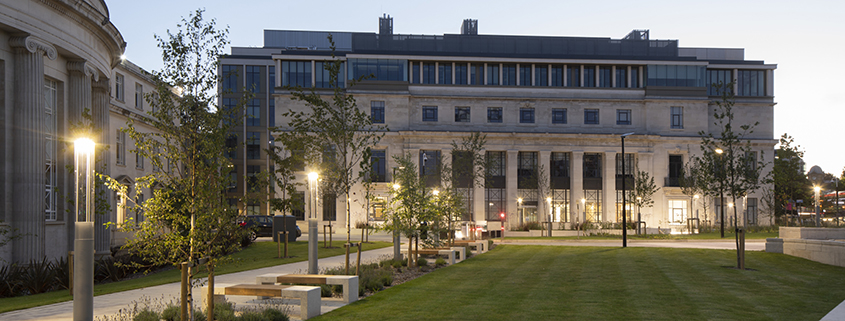Official opening for Sir William Henry Bragg Building
Last updated on 8 June 2022
The Sir William Henry Bragg Building had its official opening on Monday 6 June 2022.
Marked by a series of events as part of the opening ceremony, the building is home to the Faculty of Engineering and Physical Sciences and a state-of-the-art integrated teaching and research facility, designed to help the University achieve its strategic aim of making a positive difference in the world.
Open for use in October last year, it has achieved a BREEAM Excellent rating for sustainability. The light-filled atrium provides social breakout and collaboration space for staff and students, including the 1915 Café.
How ‘The Bragg’ was built
Work began in May 2017 with the clearance of an office building, plumbing and locking workshops and an old boiler house.
The Portland stone façade of the Grade II listed Old Mining Building, built in 1930, was retained and incorporated into the design, blending the past with the present.
Behind it, a walkway connects a new seven-storey glass and steel complex with teaching rooms and laboratories.
At the heart of the design is a desire to break down traditional boundaries. In robotics, for example, the new space will allow computer science experts to work with colleagues from electronic, electrical and mechanical engineering.
This theme is reflected in a sculpture by artist Sara Barker on an exterior wall called ‘The Worlds of If’, a reference to the possibilities unlocked when experts share ideas.
Cutting-edge facilities
When finalised, the building will house:
- A mock operating theatre where engineers can work with clinicians on robots for medicine and healthcare.
- The Wolfson Imaging Facility which will enable scientists to see molecules interacting in real time in more detail than ever before.
- Work in the Bragg Centre for Materials Research will help establish the UK as a centre for the design and manufacture of new advanced materials to solve some of the big problems facing the world.
- The University is a founding partner of the Henry Royce Institute for Advanced Materials, and the Institute’s work at Leeds will be co-located in the building with the Bragg Centre for Materials Research. Work will focus on manipulating and developing materials at the scale of individual atoms.
About the Braggs
The Braggs were awarded the Nobel Prize for Physics in 1915 for their pioneering research at Leeds. Their work involved the proposal of an equation that allowed the position of atoms within crystals to be determined from X-ray photographs.
Take a look at the Bragg Building in action…
Find out more about the construction of The Sir William Henry Bragg Building.




